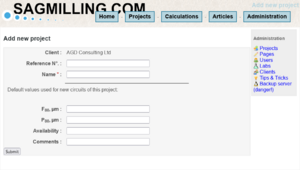Entering test results
Entering Test Results
A newly created project will require entry of test results before circuit models may be created and run. To enter test results, click the "See Testwork results" link.
The testwork page consists of a series of links to the individual pages for storing different types of test results. It will first show a summary of all the results that have been entered — but since no test results are entered, the summary says "No results found.".
General Concepts
The testing program should collect a series of samples corresponding to a particular interval of drill core, mine bench or some other reasonably uniform composite. Each sample will then have a series of tests conducted on it depending on which model (or models) are intended to be run. In order to properly index and organize the databases, each sample must have the following:
- Sample: Sample name that is unique. This can be a number, a drillhole number:from-to interval, or any other unique identifier. The same sample name will be used in all the tests in order to tell the database that "this is the same sample" when it goes looking to gather information.
- Program: Used to group tests that were all part of the same batch of testing. Often this is denoted by the date of testing, lab name or part of the orebody that was being examined.
The database will only match samples (across the different tests) if both the Sample and Program entries are identical. Enter these two values with care, otherwise the database won't be able to gather together the required tests for modelling, and samples will be missed from any calculations.
There are three ways to enter a test result:
- entering on test at a time by filling in the fields for a "single test result";
- cutting & pasting a table of values from a spreadsheet in a "batch";
- cloning an existing test result (won't be available until some values are entered that can be cloned).
Test Types
Click on the link of the type of test that you want to enter date for. The abbreviations (on the list of links) for the different tests are:
- wibm: Bond ball mill work index (sometimes called "BWI")
- wirm: Bond rod mill work index (sometimes called "RWI")
- wic: Bond crushing work index (low energy impact, sometimes called "LEIT", "IWI" or "CWI")
- dwt: Drop Weight tests, SMC Test ® of SMCC Pty Ltd. and JK DWT (values stored include A×b and DWI)
- spi: SAG Power Index (SPI ® of SGS Mineral Services; originally called a "Starkey SAG test"Starkey et al, 1994)
- ai: Bond abrasion index
- litho: Lithological, alteration and sample acquisition data, including drill hole intervals
- geotech: Geotechnical parameters that can sometimes be used as grindability proxies (RQD, r-value, fracture frequency)
- ucs: Unconfined Compressive Strength, a detailed geotechnical test conducted on drill core
- pli: Point Load Index, a field-test conducted on drill core
Laboratory names
The laboratory where a test was conducted can be recorded with each sample. This is generally used for quality-control duplicate purposes in large testwork programs.
The list of laboratory names is pre-populated with a number of laboratories whose results have been used in model calibration during the development of SAGMILLING.COM. The listing of labs is accessible via the "+" button at the top of every set of testwork. This "+" button option "Show lab listing" brings up the list.
The listing can be modified the same as any testwork value. Clicking the "id" button will allow a row to be edited, and new entries can be added using the "Enter New Result" link at the bottom of the list.
